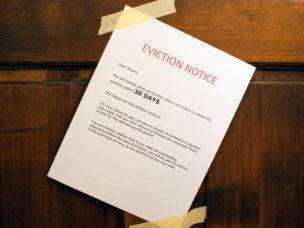Stay in the know
Subscribe to the Real Estate Blog and we’ll send you an email each time something new is posted.
Subscribe to the Real Estate Blog and we’ll send you an email each time something new is posted.
Blogs
Real Estate Blog
Rent Relief Considerations in the Time of COVID-19
“In any moment of decision the best thing you can do is the right thing, the next best thing is the wrong thing, and the worst thing you can do is nothing,” said Theodore Roosevelt.
By now, everyone recognizes the havoc and uncertainty of the Coronavirus’s impact on almost every aspect of the commercial real estate sector – e.g., 630,000 US retail locations have closed, with the office and other sectors experiencing similar impacts. The duration of this crisis is uncertain, but in this evolving situation, every landlord, tenant, lender, and investor is processing and planning next steps with respect to their real estate relationship counterparties (while at the same time determining the applicability, if any, of insurance coverages; the applicability, timing, and requirements of government stimulus programs, such as the CARES Act; and countless other business continuity challenges). As April rents and debt payments come due or past due, many have already reached out to their counterparties (or their lawyers) to discuss short term solutions. These conversations are important to have.
While each situation may have unique aspects, and the lease language and overall relationship between the parties play a significant role in the outcome, there are some possible approaches for landlords and tenants to consider at this time including the following:
Rent Deferral: An agreement to defer all or a portion of rent (be it fixed or basic rent and some or all of the additional rent components – operating costs, taxes, insurance, etc. – due under the lease) for a defined period – say 60, 90 or 120 days. Deferred rent would then be repaid at some later date either in a lump sum or amortized (with or without an interest component) and repaid over a defined period once full rent commences – ideally, from a landlord’s perspective, quickly following full rent commencement, but this may vary based on many factors, including the tenant’s business operations and the landlord’s asset “hold” period. Restructured short-term repayment agreements deliver some immediate structure and “certainty” while providing tenant rent relief and maintaining the landlord’s cash flow under the lease, albeit restructured and extended, without adding defaulting tenants to the rent roll.
Rent Abatement/Tolling: An agreement to simply abate or “toll” rent (again, all or a portion of the various rent components) for a fixed period. After the abatement period, rent would recommence. This abatement approach provides tenant breathing room and cash flow relief but does not address the landlord’s on-going obligations – debt service, taxes and operating costs (although the landlord may be seeking similar relief from some of these). Accordingly, a landlord may resist this or add the abatement or tolling period to the end of the lease term (at what may then be higher rents).
Rent Reduction: An agreement to simply reduce rent for a short period of time to get tenant over the “hump” of the crisis while maintaining some level of cash flow to the landlord. While more economically favorable to the tenant than the landlord, this approach may provide other relationship benefits when coupled with other factors, such as an agreement to exercise (or not exercise) an extension or other option, future rent restructuring or other agreement.
Tapping the Security Deposit: An agreement or understanding that a landlord can apply some or all of the cash security deposit to rent shortfalls may provide a liquidity solution for both parties during the short term. The agreement could include replenishing of the security deposit at a later date or over time, or treat the reduction as a burn-down or burn-off.
Hardline: Some landlords and tenants will elect a more aggressive approach – exercising defaults and further remedies based on non-performance, or asserting that non-performance is excused or extended during the current Coronavirus pandemic based on lease language or legal doctrines (e.g., force majeure, impossibility or impracticability, frustration of purpose, etc.). In some situations, this approach may be appropriate. For instance, non-performance where a tenant is clearly not impacted or where the lease documents unambiguously prohibit such non-performance (e.g., a fully-net ground lease). It is also likely that a few will use this situation as a pretext for unrelated non-performance. Regardless of merit, these positions may simply set a difficult tone during and after the resolution, and the current court closures and restrictions (and likely backlog when those abate) won’t easily or quickly allow for a judicial determination.
Other considerations include the following:
Realistic Expectations: Set and seek goals that are practical and reasonable in terms of economics and duration and workable for all parties to the extent discernible and practical. While unilateral actions may be or become necessary, a mutually agreeable short term solution to span this crisis will likely leave parties in better positions post-Coronavirus impact.
Transparency: In order to seek and obtain relief, the requesting party should be willing to provide some level of transparency and evidence of hardship if requested. At the same time, while a showing of need may be important, requests for this information should be realistic and practical given the situation and fit the scope of the tenant and situation – rather than an exhaustive list difficult to quickly provide in current circumstances. This shouldn’t simply be a hurdle landlords use to reject requests, but landlords may need to explain, share or at least attest to tenant restructurings in order to obtain lender approval or latitude under loan documents to grant relief. Similarly, landlords may want to explain the limitations they face due to underlying financing or other restrictions.
Competent Planning: While difficult to assess the duration of the current situation, any request for relief should be accompanied by a competent and professional showing that there is a current plan to bridge the crisis based on realistic assumptions and that relevant stakeholders are putting skin in the game.
Lender (or Other) Approval: Parties should keep in mind that third party (e.g., lender) approvals may be necessary to restructure or amend leases. Consider seeking programmatic approval for parameters to restructuring/relief deals now to cut down on individual approvals.
Other Issues or Concerns: This may be an opportunity to address other outstanding issues or concerns providing the benefit to the other party and allowing relief to go forward – such as extending the term, waiving rights, acknowledging facts, etc. The degree of leveraging these issues during a crisis, however, should be prudently and strategically applied.
Documentation: Any agreement to modify, restructure or affect a lease should be in writing. This step is essential to ensure there’s an actual agreement to actual terms and conditions – even stripped-down writing is better than none.
This crisis has placed significant stress on both sides of the landlord-tenant equation. Both sides have suddenly found their operations interrupted, cash flow jeopardized, business continuity models upended, and have had their ability to perform their obligations to their lenders, investors, employees, and clients and customers severely strained. To the extent practical, each party should seek the mutually shared goal in this time to outlast the crisis impact in a manner that allows as quick a recovery as possible. Reach out to the Sherin and Lodgen team with any questions or to discuss specific situations.
We continue to monitor the impact of COVID-19 on our clients’ respective industries and advise accordingly. Click here for a full list of Sherin and Lodgen’s Client Alerts.


